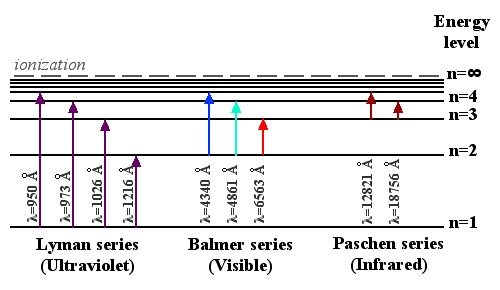Now, use the connection between temperature and line strength to see what you can understand about stars. Look back at the classes you wrote in the table in Explore 7, and answer the questions below.
Question 9. What two classes of stars have the strongest Hα lines? Are these the hottest stars? The coolest? How hot are these stars?
Question 10. Which class of stars is the hottest? Which class of stars is the coolest? How strong are the Hα lines for these two classes of stars?
Take another look at this chart that you saw earlier:

Question 11. Which transition corresponds to the Hα lines that you have been using to classify?
What energy state do the electrons in the stars with strong Ha lines start in (before making their transitions to other states)?
Question 12. Take another look at the chart above. What energy levels might you expect the electrons in the hydrogen of hotter stars to start in? What energy level might you expect to see in the electrons of hydrogen in a colder star? Why might these hot and cold stars show very weak Hα lines?
Question 13. A hydrogen atom with an electron in n=1 exists as neutral hydrogen; a hydrogen atom with electrons in a higher energy level loses an electron to become a hydrogen ion. What classes of stars have a lot of neutral hydrogen? How hot are these stars? What classes of stars have a lot of ionized hydrogen? How hot are these stars?
Question 14. Stars are composed primarily of hydrogen. But among the stars you classified, stars 1, 4, and 5 have other spectral lines that are much more prominent. If hydrogen is the main component of stars, why isn’t Hα the most prominent absorption line in every star?
Question 15. The accepted ordering for spectral classes among astronomers is OBAFGKM. You may have learned the classes with the phrase “Oh, be a fine girl/guy, kiss me.” Why do the classes appear in this order?
Why do you think astronomers decided to re-order the spectral classes instead of just redefining what the letters meant (that is, changing what a class “A” star was)?
